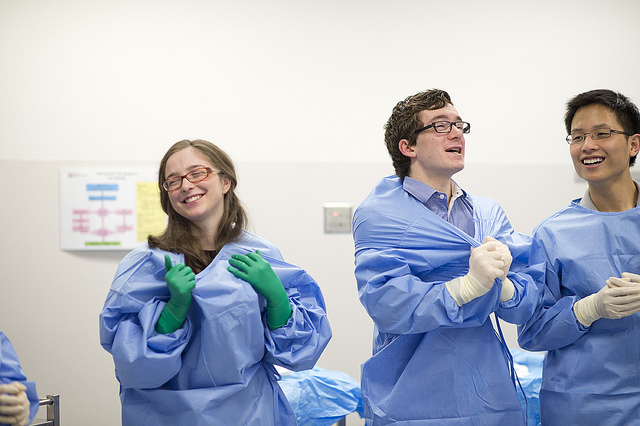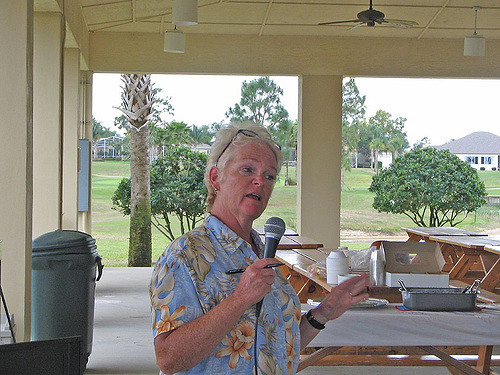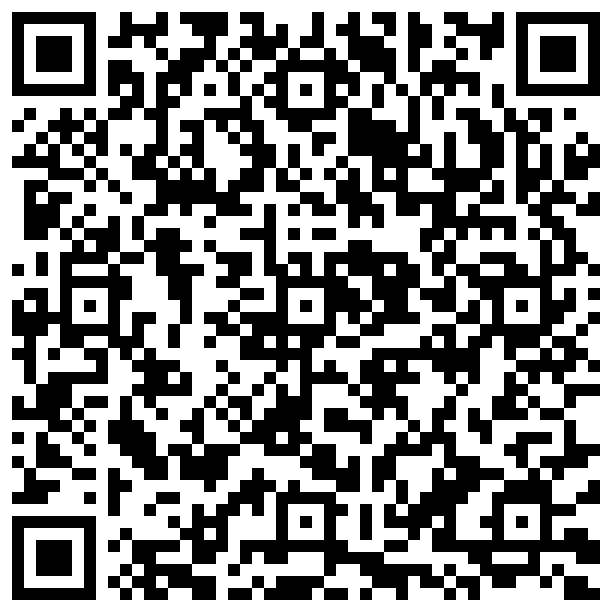
Many people would rather go see an impassioned political speech or a comedic monologue than a lecture. Although informative speaking may not be the most exciting form of public speaking, it is the most common. Reports, lectures, training seminars, and demonstrations are all examples of informative speaking. That means you are more likely to give and listen to informative speeches in a variety of contexts. Some organizations, like consulting firms, and career fields, like training and development, are solely aimed at conveying information. College alumni have reported that out of many different speech skills, informative speaking is most important (Verderber, 1991). Since your exposure to informative speaking is inevitable, why not learn how to be a better producer and consumer of informative messages?
As you’ll recall from Chapter 9 “Preparing a Speech”, speaking to inform is one of the three possible general purposes for public speaking. The goal of informative speaking is to teach an audience something using objective factual information. Interestingly, informative speaking is a newcomer in the world of public speaking theorizing and instruction, which began thousands of years ago with the ancient Greeks (Olbricht, 1968). Ancient philosophers and statesmen like Aristotle, Cicero, and Quintilian conceived of public speaking as rhetoric, which is inherently persuasive. During that time, and until the 1800s, almost all speaking was argumentative. Teaching and instruction were performed as debates, and even fields like science and medicine relied on argumentative reasoning instead of factual claims.

Until the 1800s, even scientific fields and medicine relied on teaching that was based on debate and argument rather than the informative-based instruction that is used today.
Monash University – Surgery Workshop 2012 – CC BY-NC 2.0.
While most instruction is now verbal, for most of modern history, people learned by doing rather than listening, as apprenticeships were much more common than classroom-based instruction. So what facilitated the change from argumentative and demonstrative teaching to verbal and informative teaching? One reason for this change was the democratization of information. Technical information used to be jealously protected by individuals, families, or guilds. Now society generally believes that information should be shared and made available to all. The increasing complexity of fields of knowledge and professions also increased the need for informative speaking. Now one must learn a history or backstory before actually engaging with a subject or trade. Finally, much of the information that has built up over time has become commonly accepted; therefore much of the history or background information isn’t disputed and can now be shared in an informative rather than argumentative way.
Being a successful informative speaker starts with choosing a topic that can engage and educate the audience. Your topic choices may be influenced by the level at which you are speaking. Informative speaking usually happens at one of three levels: formal, vocational, and impromptu (Verderber, 1991). Formal informative speeches occur when an audience has assembled specifically to hear what you have to say. Being invited to speak to a group during a professional meeting, a civic gathering, or a celebration gala brings with it high expectations. Only people who have accomplished or achieved much are asked to serve as keynote speakers, and they usually speak about these experiences. Many more people deliver informative speeches at the vocational level, as part of their careers. Teachers like me spend many hours lecturing, which is a common form of informative speaking. In addition, human resources professionals give presentations about changes in policy and provide training for new employees, technicians in factories convey machine specifications and safety procedures, and servers describe how a dish is prepared in their restaurant. Last, we all convey information daily in our regular interactions. When we give a freshman directions to a campus building, summarize the latest episode of American Idol for our friend who missed it, or explain a local custom to an international student, we are engaging in impromptu informative speaking.
Whether at the formal, vocational, or impromptu level, informative speeches can emerge from a range of categories, which include objects, people, events, processes, concepts, and issues. An extended speech at the formal level may include subject matter from several of these categories, while a speech at the vocational level may convey detailed information about a process, concept, or issue relevant to a specific career.

Subjects of informative speaking at the vocational level usually relate to a speaker’s professional experience or expertise.
Peter Long – Business Meeting – CC BY 2.0.
Since we don’t have time to research or organize content for impromptu informative speaking, these speeches may provide a less detailed summary of a topic within one of these categories. A broad informative speech topic could be tailored to fit any of these categories. As you draft your specific purpose and thesis statements, think about which category or categories will help you achieve your speech goals, and then use it or them to guide your research. Table 11.1 “Sample Informative Speech Topics by Category” includes an example of how a broad informative subject area like renewable energy can be adapted to each category as well as additional sample topics.
Table 11.1 Sample Informative Speech Topics by Category
| Category | Renewable Energy Example | Other Examples |
|---|---|---|
| Objects | Biomass gasifier | Tarot cards, star-nosed moles, Enterprise 1701-D |
| People | Al Gore | Jennifer Lopez, Bayard Rustin, the Amish |
| Concepts | Sustainability | Machismo, intuition, Wa (social harmony) |
| Events | Earth Day | Pi Day, Take Back the Night, 2012 presidential election |
| Processes | Converting wind to energy | Scrapbooking, animal hybridization, Academy Awards voting |
| Issues | Nuclear safety | Cruise ship safety, identity theft, social networking and privacy |
Speeches about objects convey information about any nonhuman material things. Mechanical objects, animals, plants, and fictional objects are all suitable topics of investigation. Given that this is such a broad category, strive to pick an object that your audience may not be familiar with or highlight novel relevant and interesting facts about a familiar object.
Speeches about people focus on real or fictional individuals who are living or dead. These speeches require in-depth biographical research; an encyclopedia entry is not sufficient. Introduce a new person to the audience or share little-known or surprising information about a person we already know. Although we may already be familiar with the accomplishments of historical figures and leaders, audiences often enjoy learning the “personal side” of their lives.
Speeches about concepts are less concrete than speeches about objects or people, as they focus on ideas or notions that may be abstract or multifaceted. A concept can be familiar to us, like equality, or could literally be a foreign concept like qi (or chi), which is the Chinese conception of the energy that flows through our bodies. Use the strategies discussed in this book for making content relevant and proxemic to your audience to help make abstract concepts more concrete.
Speeches about events focus on past occasions or ongoing occurrences. A particular day in history, an annual observation, or a seldom occurring event can each serve as interesting informative topics. As with speeches about people, it’s important to provide a backstory for the event, but avoid rehashing commonly known information.
Informative speeches about processes provide a step-by-step account of a procedure or natural occurrence. Speakers may walk an audience through, or demonstrate, a series of actions that take place to complete a procedure, such as making homemade cheese. Speakers can also present information about naturally occurring processes like cell division or fermentation.

Informative speeches about processes provide steps of a procedure, such as how to make homemade cheese.
Joel Kramer – curdle – CC BY 2.0.
Last, informative speeches about issues provide objective and balanced information about a disputed subject or a matter of concern for society. It is important that speakers view themselves as objective reporters rather than commentators to avoid tipping the balance of the speech from informative to persuasive. Rather than advocating for a particular position, the speaker should seek to teach or raise the awareness of the audience.
Having sharp research skills is a fundamental part of being a good informative speaker. Since informative speaking is supposed to convey factual information, speakers should take care to find sources that are objective, balanced, and credible. Periodicals, books, newspapers, and credible websites can all be useful sources for informative speeches, and you can use the guidelines for evaluating supporting materials discussed in Chapter 9 “Preparing a Speech” to determine the best information to include in your speech. Aside from finding credible and objective sources, informative speakers also need to take time to find engaging information. This is where sharp research skills are needed to cut through all the typical information that comes up in the research process to find novel information. Novel information is atypical or unexpected, but it takes more skill and effort to locate. Even seemingly boring informative speech topics like the history of coupons can be brought to life with information that defies the audience’s expectations. A student recently delivered an engaging speech about coupons by informing us that coupons have been around for 125 years, are most frequently used by wealthier and more educated households, and that a coupon fraud committed by an Italian American businessman named Charles Ponzi was the basis for the term Ponzi scheme, which is still commonly used today.
As a teacher, I can attest to the challenges of keeping an audience engaged during an informative presentation. While it’s frustrating to look out at my audience of students and see glazed-over eyes peering back at me, I also know that it is my responsibility to choose interesting information and convey it in a way that’s engaging. Even though the core content of what I teach hasn’t change dramatically over the years, I constantly challenge myself to bring that core information to life through application and example. As we learned earlier, finding proxemic and relevant information and examples is typically a good way to be engaging. The basic information may not change quickly, but the way people use it and the way it relates to our lives changes. Finding current, relevant examples and finding novel information are both difficult, since you, as the researcher, probably don’t know this information exists.
Here is where good research skills become necessary to be a good informative speaker. Using advice from Chapter 9 “Preparing a Speech” should help you begin to navigate through the seas of information to find hidden treasure that excites you and will in turn excite your audience.

To avoid boring an audience, effective informative speakers possess good research skills and the ability to translate information to be engaging and relevant for an audience.
Niall Kennedy – Sleep – CC BY-NC 2.0.
As was mentioned earlier, the goal for informative speaking is to teach your audience. An audience is much more likely to remain engaged when they are actively learning. This is like a balancing act. You want your audience to be challenged enough by the information you are presenting to be interested, but not so challenged that they become overwhelmed and shut down. You should take care to consider how much information your audience already knows about a topic. Be aware that speakers who are very familiar with their speech topic tend to overestimate their audience’s knowledge about the topic. It’s better to engage your topic at a level slightly below your audience’s knowledge level than above. Most people won’t be bored by a brief review, but many people become lost and give up listening if they can’t connect to the information right away or feel it’s over their heads.
A good informative speech leaves the audience thinking long after the speech is done. Try to include some practical “takeaways” in your speech. I’ve learned many interesting and useful things from the informative speeches my students have done. Some of the takeaways are more like trivia information that is interesting to share—for example, how prohibition led to the creation of NASCAR. Other takeaways are more practical and useful—for example, how to get wine stains out of clothing and carpet or explanations of various types of student financial aid.
You can already see that informing isn’t as easy as we may initially think. To effectively teach, a speaker must present quality information in an organized and accessible way. Once you have chosen an informative speech topic and put your research skills to the test in order to locate novel and engaging information, it’s time to organize and support your speech.
Three organizational patterns that are particularly useful for informative speaking are topical, chronological, and spatial. As you’ll recall, to organize a speech topically, you break a larger topic down into logical subdivisions. An informative speech about labor unions could focus on unions in three different areas of employment, three historically significant strikes, or three significant legal/legislative decisions. Speeches organized chronologically trace the development of a topic or overview the steps in a process. An informative speech could trace the rise of the economic crisis in Greece or explain the steps in creating a home compost pile. Speeches organized spatially convey the layout or physical characteristics of a location or concept. An informative speech about the layout of a fire station or an astrology wheel would follow a spatial organization pattern.
Types of and strategies for incorporating supporting material into speeches are discussed in Chapter 9 “Preparing a Speech”, but there are some specific ways to go about developing ideas within informative speeches. Speakers often inform an audience using definitions, descriptions, demonstrations, and explanations. It is likely that a speaker will combine these methods of informing within one speech, but a speech can also be primarily organized using one of these methods.
Informing through definition entails defining concepts clearly and concisely and is an important skill for informative speaking. There are several ways a speaker can inform through definition: synonyms and antonyms, use or function, example, and etymology (Verderber, 1991). Defining a concept using a synonym or an antonym is a short and effective way to convey meaning. Synonyms are words that have the same or similar meanings, and antonyms are words that have opposite meanings. In a speech about how to effectively inform an audience, I would claim that using concrete words helps keep an audience engaged. I could enhance your understanding of what concrete means by defining it with synonyms like tangible and relatable. Or I could define concrete using antonyms like abstract and theoretical.
Identifying the use or function of an object, item, or idea is also a short way of defining. We may think we already know the use and function of most of the things we interact with regularly. This is true in obvious cases like cars, elevators, and smartphones. But there are many objects and ideas that we may rely on and interact with but not know the use or function. For example, QR codes (or quick response codes) are popping up in magazines, at airports, and even on t-shirts (Vuong, 2011). Many people may notice them but not know what they do. As a speaker, you could define QR codes by their function by informing the audience that QR codes allow businesses, organizations, and individuals to get information to consumers/receivers through a barcode-like format that can be easily scanned by most smartphones.

An informative speaker could teach audience members about QR codes by defining them based on their use or function.
Douglas Muth – My QR Code – CC BY-SA 2.0.
A speaker can also define a topic using examples, which are cited cases that are representative of a larger concept. In an informative speech about anachronisms in movies and literature, a speaker might provide the following examples: the film Titanic shows people on lifeboats using flashlights to look for survivors from the sunken ship (such flashlights weren’t invented until two years later) (The Past in Pictures, 2012); Shakespeare’s play Julius Caesar includes a reference to a clock, even though no mechanical clocks existed during Caesar’s time (Scholasticus K., 2012). Examples are a good way to repackage information that’s already been presented to help an audience retain and understand the content of a speech. Later we’ll learn more about how repackaging information enhances informative speaking.
Etymology refers to the history of a word. Defining by etymology entails providing an overview of how a word came to its current meaning. The Oxford English Dictionary is the best source for finding etymology and often contains interesting facts that can be presented as novel information to better engage your audience. For example, the word assassin, which refers to a person who intentionally murders another, literally means “hashish-eater” and comes from the Arabic word hashshashin. The current meaning emerged during the Crusades as a result of the practices of a sect of Muslims who would get high on hashish before killing Christian leaders—in essence, assassinating them (Oxford English Dictionary Online, 2012).
As the saying goes, “Pictures are worth a thousand words.” Informing through description entails creating verbal pictures for your audience. Description is also an important part of informative speeches that use a spatial organizational pattern, since you need to convey the layout of a space or concept. Good descriptions are based on good observations, as they convey what is taken in through the senses and answer these type of questions: What did that look like? Smell like? Sound like? Feel like? Taste like? If descriptions are vivid and well written, they can actually invoke a sensory reaction in your audience. Just as your mouth probably begins to salivate when I suggest that you imagine biting into a fresh, bright yellow, freshly cut, juicy lemon wedge, so can your audience be transported to a setting or situation through your descriptions. I once had a student set up his speech about the history of streaking by using the following description: “Imagine that you are walking across campus to your evening class. You look up to see a parade of hundreds upon hundreds of your naked peers jogging by wearing little more than shoes.”
When informing through demonstration , a speaker gives verbal directions about how to do something while also physically demonstrating the steps. Early morning infomercials are good examples of demonstrative speaking, even though they are also trying to persuade us to buy their “miracle product.” Whether straightforward or complex, it’s crucial that a speaker be familiar with the content of their speech and the physical steps necessary for the demonstration. Speaking while completing a task requires advanced psycho-motor skills that most people can’t wing and therefore need to practice. Tasks suddenly become much more difficult than we expect when we have an audience. Have you ever had to type while people are reading along with you? Even though we type all the time, even one extra set of eyes seems to make our fingers more clumsy than usual.
Television chefs are excellent examples of speakers who frequently inform through demonstration. While many of them make the process of speaking while cooking look effortless, it took much practice over many years to make viewers think it is effortless.

Television chefs inform through demonstration. Although they make it seem easy, it is complex and difficult.
Gordonramsaysubmissions – gordon ramsay 7 – CC BY 2.0.
Part of this practice also involves meeting time limits. Since television segments are limited and chefs may be demonstrating and speaking live, they have to be able to adapt as needed. Demonstration speeches are notorious for going over time, especially if speakers haven’t practiced with their visual aids / props. Be prepared to condense or edit as needed to meet your time limit. The reality competition show The Next Food Network Star captures these difficulties, as many experienced cooks who have the content knowledge and know how to physically complete their tasks fall apart when faced with a camera challenge because they just assumed they could speak and cook at the same time.
Tips for Demonstration Speeches
Informing through explanation entails sharing how something works, how something came to be, or why something happened. This method of informing may be useful when a topic is too complex or abstract to demonstrate. When presenting complex information make sure to break the topic up into manageable units, avoid information overload, and include examples that make the content relevant to the audience. Informing through explanation works well with speeches about processes, events, and issues. For example, a speaker could explain the context surrounding the Lincoln-Douglas debates or the process that takes place during presidential primaries.
TED Talks as a Model of Effective Informative Speaking
Over the past few years, I have heard more and more public speaking teachers mention their use of TED speeches in their classes. What started in 1984 as a conference to gather people involved in Technology, Entertainment, and Design has now turned into a worldwide phenomenon that is known for its excellent speeches and presentations, many of which are informative in nature. [1] The motto of TED is “Ideas worth spreading,” which is in keeping with the role that we should occupy as informative speakers. We should choose topics that are worth speaking about and then work to present them in such a way that audience members leave with “take-away” information that is informative and useful. TED fits in with the purpose of the “Getting Plugged In” feature in this book because it has been technology focused from the start. For example, Andrew Blum’s speech focuses on the infrastructure of the Internet, and Pranav Mistry’s speech focuses on a new technology he developed that allows for more interaction between the physical world and the world of data. Even speakers who don’t focus on technology still skillfully use technology in their presentations, as is the case with David Gallo’s speech about exotic underwater life. Here are links to all these speeches:
There are several challenges to overcome to be an effective informative speaker. They include avoiding persuasion, avoiding information overload, and engaging your audience.
We should avoid thinking of informing and persuading as dichotomous, meaning that it’s either one or the other. It’s more accurate to think of informing and persuading as two poles on a continuum, as in Figure 11.1 “Continuum of Informing and Persuading” (Olbricht, 1968). Most persuasive speeches rely on some degree of informing to substantiate the reasoning. And informative speeches, although meant to secure the understanding of an audience, may influence audience members’ beliefs, attitudes, values, or behaviors.
Figure 11.1 Continuum of Informing and Persuading

Speakers can look to three areas to help determine if their speech is more informative or persuasive: speaker purpose, function of information, and audience perception (Verderber, 1991). First, for informative speaking, a speaker’s purpose should be to create understanding by sharing objective, factual information. Specific purpose and thesis statements help establish a speaker’s goal and purpose and can serve as useful reference points to keep a speech on track. When reviewing your specific purpose and thesis statement, look for words like should/shouldn’t, good/bad, and right/wrong, as these often indicate a persuasive slant in the speech.
Second, information should function to clarify and explain in an informative speech. Supporting materials shouldn’t function to prove a thesis or to provide reasons for an audience to accept the thesis, as they do in persuasive speeches. Although informative messages can end up influencing the thoughts or behaviors of audience members, that shouldn’t be the goal.
Third, an audience’s perception of the information and the speaker helps determine whether a speech is classified as informative or persuasive. The audience must perceive that the information being presented is not controversial or disputed, which will lead audience members to view the information as factual. The audience must also accept the speaker as a credible source of information. Being prepared, citing credible sources, and engaging the audience help establish a speaker’s credibility. Last, an audience must perceive the speaker to be trustworthy and not have a hidden agenda. Avoiding persuasion is a common challenge for informative speakers, but it is something to consider, as violating the speaking occasion may be perceived as unethical by the audience. Be aware of the overall tone of your speech by reviewing your specific purpose and thesis to make sure your speech isn’t tipping from informative to persuasive.

Words like should/shouldn’t, good/bad, and right/wrong in a specific purpose and/or thesis statement often indicate that the speaker’s purpose is tipping from informative to persuasive.
Hans Splinter – balance – CC BY-ND 2.0.
Many informative speakers have a tendency to pack a ten-minute speech with as much information as possible. This can result in information overload , which is a barrier to effective listening that occurs when a speech contains more information than an audience can process. Editing can be a difficult task, but it’s an important skill to hone, because you will be editing more than you think. Whether it’s reading through an e-mail before you send it, condensing a report down to an executive summary, or figuring out how to fit a client’s message on the front page of a brochure, you will have to learn how to discern what information is best to keep and what can be thrown out. In speaking, being a discerning editor is useful because it helps avoid information overload. While a receiver may not be attracted to a brochure that’s covered in text, they could take the time to read it, and reread it, if necessary. Audience members cannot conduct their own review while listening to a speaker live. Unlike readers, audience members can’t review words over and over (Verderber, 1991). Therefore competent speakers, especially informative speakers who are trying to teach their audience something, should adapt their message to a listening audience. To help avoid information overload, adapt your message to make it more listenable.
Although the results vary, research shows that people only remember a portion of a message days or even hours after receiving it (Janusik, 2012). If you spend 100 percent of your speech introducing new information, you have wasted approximately 30 percent of your time and your audience’s time. Information overload is a barrier to effective listening, and as good speakers, we should be aware of the limitations of listening and compensate for that in our speech preparation and presentation. I recommend that my students follow a guideline that suggests spending no more than 30 percent of your speech introducing new material and 70 percent of your speech repackaging that information. I specifically use the word repackaging and not repeating. Simply repeating the same information would also be a barrier to effective listening, since people would just get bored. Repackaging will help ensure that your audience retains most of the key information in the speech. Even if they don’t remember every example, they will remember the main underlying point.
Avoiding information overload requires a speaker to be a good translator of information. To be a good translator, you can compare an unfamiliar concept with something familiar, give examples from real life, connect your information to current events or popular culture, or supplement supporting material like statistics with related translations of that information. These are just some of the strategies a good speaker can use. While translating information is important for any oral presentation, it is especially important when conveying technical information. Being able to translate complex or technical information for a lay audience leads to more effective informing, because the audience feels like they are being addressed on their level and don’t feel lost or “talked down to.” The History Channel show The Universe provides excellent examples of informative speakers who act as good translators. The scientists and experts featured on the show are masters of translating technical information, like physics, into concrete examples that most people can relate to based on their everyday experiences.

Comparing the turbulent formation of the solar system to the collisions of bumper bars and spinning rides at an amusement park makes the content more concrete.
Alexander Svensson – Ferris Wheel – CC BY 2.0.
Following the guidelines established in Chapter 9 “Preparing a Speech” for organizing a speech can also help a speaker avoid information overload. Good speakers build in repetition and redundancy to make their content more memorable and their speech more consumable. Preview statements, section transitions, and review statements are some examples of orienting material that helps focus an audience’s attention and facilitates the process of informing (Verderber, 1991).
As a speaker, you are competing for the attention of your audience against other internal and external stimuli. Getting an audience engaged and then keeping their attention is a challenge for any speaker, but it can be especially difficult when speaking to inform. As was discussed earlier, once you are in the professional world, you will most likely be speaking informatively about topics related to your experience and expertise. Some speakers fall into the trap of thinking that their content knowledge is enough to sustain them through an informative speech or that their position in an organization means that an audience will listen to them and appreciate their information despite their delivery. Content expertise is not enough to be an effective speaker. A person must also have speaking expertise (Verderber, 1991). Effective speakers, even renowned experts, must still translate their wealth of content knowledge into information that is suited for oral transmission, audience centered, and well organized. I’m sure we’re all familiar with the stereotype of the absentminded professor or the genius who thinks elegantly in his or her head but can’t convey that same elegance verbally. Having well-researched and organized supporting material is an important part of effective informative speaking, but having good content is not enough.
Audience members are more likely to stay engaged with a speaker they view as credible. So complementing good supporting material with a practiced and fluent delivery increases credibility and audience engagement. In addition, as we discussed earlier, good informative speakers act as translators of information. Repackaging information into concrete familiar examples is also a strategy for making your speech more engaging. Understanding relies on being able to apply incoming information to life experiences.
Repackaging information is also a good way to appeal to different learning styles, as you can present the same content in various ways, which helps reiterate a point. While this strategy is useful with any speech, since the goal of informing is teaching, it makes sense to include a focus on learning within your audience adaptation. There are three main learning styles that help determine how people most effectively receive and process information: visual, auditory, and kinesthetic (Fleming, 2012). Visual learners respond well to information presented via visual aids, so repackage information using text, graphics, charts and other media. Public speaking is a good way to present information for auditory learners who process information well when they hear it. Kinesthetic learners are tactile; they like to learn through movement and “doing.” Asking for volunteers to help with a demonstration, if appropriate, is a way to involve kinesthetic learners in your speech. You can also have an interactive review activity at the end of a speech, much like many teachers incorporate an activity after a lesson to reinforce the material.
People who work in technical fields, like engineers and information technology professionals, often think they will be spared the task of public speaking. This is not the case, however, and there is actually a branch of communication studies that addresses public speaking matters for “techies.” The field of technical communication focuses on how messages can be translated from expert to lay audiences. I actually taught a public speaking class for engineering students, and they basically had to deliver speeches about the things they were working on in a way that I could understand. I ended up learning a lot more about jet propulsion and hybrid car engines than I ever expected!
Have you ever been completely lost when reading an instruction manual for some new product you purchased? Have you ever had difficulty following the instructions of someone who was trying to help you with a technical matter? If so, you’ve experienced some of the challenges associated with technical speaking. There are many careers where technical speaking skills are needed. According to the Society for Technical Communication, communicating about specialized or technical topics, communicating by using technology, and providing instructions about how to do something are all examples of technical speaking (Society for Technical Communication, 2012). People with technical speaking skills offer much to organizations and businesses. They help make information more useable and accessible to customers, clients, and employees. They can help reduce costs to a business by reducing unnecessary work that results from misunderstandings of instructions, by providing clear information that allows customers to use products without training or technical support and by making general information put out by a company more user friendly. Technical speakers are dedicated to producing messages that are concise, clear, and coherent (Society for Technical Communication, 2012). Such skills are used in the following careers: technical writers and editors, technical illustrators, visual designers, web designers, customer service representatives, salespeople, spokespeople, and many more.
Title: Going Green in the World of Education
General purpose: To inform
Specific purpose: By the end of my speech, the audience will be able to describe some ways in which schools are going green.
Thesis statement: The green movement has transformed school buildings, how teachers teach, and the environment in which students learn.
Attention getter: Did you know that attending or working at a green school can lead students and teachers to have less health problems? Did you know that allowing more daylight into school buildings increases academic performance and can lessen attention and concentration challenges? Well, the research I will cite in my speech supports both of these claims, and these are just two of the many reasons why more schools, both grade schools and colleges, are going green.
Introduction of topic: Today, I’m going to inform you about the green movement that is affecting many schools.
Credibility and relevance: Because of my own desire to go into the field of education, I decided to research how schools are going green in the United States. But it’s not just current and/or future teachers that will be affected by this trend. As students at Eastern Illinois University, you are already asked to make “greener” choices. Whether it’s the little signs in the dorm rooms that ask you to turn off your lights when you leave the room, the reusable water bottles that were given out on move-in day, or even our new Renewable Energy Center, the list goes on and on. Additionally, younger people in our lives, whether they be future children or younger siblings or relatives, will likely be affected by this continuing trend.
Preview statement: In order to better understand what makes a “green school,” we need to learn about how K–12 schools are going green, how college campuses are going green, and how these changes affect students and teachers.
Transition: I’ll begin with how K–12 schools are going green.
Transition: As you can see, K–12 schools are becoming greener; college campuses are also starting to go green.
Transition: All these efforts to go green in K–12 schools and on college campuses will obviously affect students and teachers at the schools.
Transition to conclusion and summary of importance: In summary, the going-green era has impacted every aspect of education in our school systems.
Review of main points: From K–12 schools to college campuses like ours, to the students and teachers in the schools, the green movement is changing the way we think about education and our environment.
Closing statement: As Glenn Cook, the editor in chief of the American School Board Journal, states on the Center for Green Schools’s website, “The green schools movement is the biggest thing to happen to education since the introduction of technology to the classroom.”
Ash, K. (2011). “Green schools” benefit budgets and students, report says. Education Week, 30(32), 10.
Calder, W. (2009). Go green, save green. Independent School, 68(4), 90–93.
Eastern Illinois University. (n.d.). Renewable Energy Center. Retrieved from http://www.eiu.edu/sustainability/eiu_renewable.php
Kats, G. (2006). Greening America’s schools: Costs and benefits. A Capital E Report. Retrieved from http://www.usgbc.org/ShowFile.aspx?DocumentID=2908
Strife, S. (2010). Reflecting on environmental education: Where is our place in the green movement? Journal of Environmental Education, 41(3), 179–191. doi:10.1080/00958960903295233
Sturm College of Law. (n.d.). About DU law: Building green. Retrieved from http://www.law.du.edu/index.php/about/building-green
USGBC. (n.d.). About us. US Green Building Council. Retrieved from https://new.usgbc.org/about
Olbricht, T. H., Informative Speaking (Glenview, IL: Scott, Foresman, 1968), 1–12.
Oxford English Dictionary Online, accessed March 6, 2012, http://www.oed.com.
The Past in Pictures, “Teaching Using Movies: Anachronisms!” accessed March 6, 2012, http://www.thepastinthepictures.wildelearning.co.uk/Introductoryunit!.htm.
Scholasticus K, “Anachronism Examples in Literature,” February 2, 2012, accessed March 6, 2012, http://www.buzzle.com/articles/anachronism-examples-in-literature.html.
Verderber, R., Essentials of Informative Speaking: Theory and Contexts (Belmont, CA: Wadsworth, 1991), 3.
Vuong, A., “Wanna Read That QR Code? Get the Smartphone App,” The Denver Post, April 18, 2011, accessed March 6, 2012, http://www.denverpost.com/business/ci_17868932.